Reading the Rooms: Behind the paintings of the State Library of New South Wales
A picture collection chosen not for its aesthetic qualities, but for the stories it tells about the people and places of New South Wales, forms the subject of this handsome volume. Building a collection of pictures around their content rather than their creators is an interesting challenge and legacy inherited by the Mitchell Library in Sydney. It’s a delight to find a collection of works wherein the history in the paintings is the headline, rather than the artist, the style, or technique—although these are important and do feature—it’s the stories that reward the viewer here.
READ REVIEW
↓
Reading the Rooms: Behind the paintings of the State Library of New South Wales
Richard Neville And Rachel Franks (Eds) | 2023
In 2018 the first in a series of new galleries opened in the State Library of New South Wales aiming to show the richness and variety of the Library’s collection. This book accompanies these new ‘walk through catalogues’ and like them, presents the visitor with a sense of the scope and scale of the collections. This is vital when so much of a state library’s collection is beyond public access.
Intended for a wide audience, Reading the Rooms is composed of the type of informal wall texts that usually accompany a picture. Here they give vital depth and detail to a collection with broad and eclectic rationale. This proves refreshing and allows for a wide variety of subjects, and less well-known artists to depict Sydney and beyond. Three essays argue persuasively for a Library displaying its picture collection and the book concludes with a catalogue.
The State Library of NSW boasts ‘one of the largest pictorial collections in Australia’. In its Mitchel Library and Dixson Galleries and Dixson Library collections, staff manage nearly 1,300 oil paintings and more than 168,000 prints, drawings and watercolours. The quality of execution and skill varies, and the subjects and formats are diverse, which—argues Richard Neville in his essay—reveals ‘a much more extensive and complex visual society than an art gallery display would suggest’ with its necessary focus on aesthetic excellence.
To locate the complexity in our past is a goal shared by many historians and art historians concerned with Australia. We wear this pride like a shield, in defense of the neglect our subject is said to receive from high school and undergraduate students. We think, ‘If only they saw the depth we do!’ As a pedagogical tool this text is perfectly designed to reach such a target: any picture may be taken as a starting point for research or observational exercises, demonstrating both the Library’s resources and the versatility of visual history approaches.
Six chapters are arranged by theme, given the somewhat perplexing titles: People, Place, Power, Providers, Pastimes and Posterity. Designed to facilitate logical groupings of artworks and still allow surprises, the pictures are chronological within each theme. The first two are straightforward and we find a cast of interesting characters and locales revealing the hoped-for complexity. Two Eugene von Guerard landscapes highlight for Christopher Allen, in his essay, the ‘sharp and sensitive observations’ made by artists before the heady mythmaking of artists like Arthur Streeton and Tom Roberts. But a viewer might just as easily see the Australian landscape transformed by colonisation, as much as accurate Australian sunlight.
The following themes prove more interesting. Power demonstrates a change in interest over time, with portraits of governors and Queen Victoria, Joseph Banks, important landowners, and soldiers, progressing to interesting women philanthropists, Māori chiefs, Chinese merchants and restauranteurs, and finally Faith Bandler, a leader in Aboriginal rights. Looking at these faces, chronology reveals a well-known story, but it also reminds us how far we’ve come and have still to go.
Providers are initially men. An interesting series of paintings by Thomas Tyrwhitt Balcombe of Aboriginal men fishing and hunting, leads to the gold rushes and other early industries. The Harbour Bridge under construction and finally two suburban streetscapes from the early 2000s reveal the land and its resources as the ultimate provider.
In Pastimes we view scenes of leisure, boating, picnicking, road tripping and swimming at the beach. Here are prosperous landscapes, pleasantly peopled. Concluding the book in a somber tone is Posterity. Among depictions of Captain Cook’s death, Bounty mutineers and early but long-gone Sydney streets we see portraits of young women painted posthumously. Two depictions of Aboriginal ceremonies and Tom Roberts’ portrait of Mariah Charles ensure this last theme includes thought provoking subjects. Mariah Charles is described as an ‘honest and realistic’ portrait of an Aboriginal woman whom the artist decided to depict while painting landowner Edward Ogilvie at Yulgilbar, near Grafton, in 1894. I did wonder why she didn’t appear sooner, perhaps under People.
The usefulness of this volume lies in its ability to augment the physical display, and its comprehensive and engaging short descriptions achieve this. This book, and its exhibition, also draws attention to the sources held by libraries and archives, beyond the expected books and manuscripts. All manner of visually inclined historians will find this text useful, as will a general reader with an interest in the nuance and detail of NSW history and beyond.
Reading the Rooms: Behind the paintings of the State Library of New South Wales is published by NewSouth.
Reviewer: Nikita Vanderbyl, PHA (Vic & Tas)

